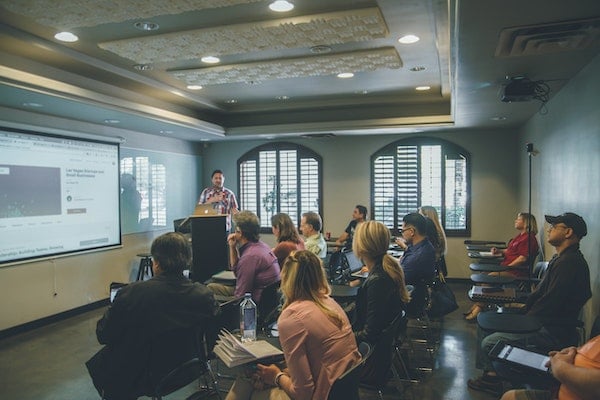Published on
Leading High-Quality Learning Opportunities

The modern learner isn’t looking for educational offerings that get them into one job. Rather, they’re looking for an institution that can lay out a career path for them to follow on their lifelong learning journey. This requires institution to strategically think about their offerings and redesigning them that fits the short-term, flexible lifestyle of today’s learners. In this interview, Bill Pink discusses the need to focus on job-focused education, the importance of designing this type of programming to meet learner needs, and what it takes from senior leaders to implement this shift.
The EvoLLLution (Evo): Why is it important for higher ed institutions broadly, but community colleges specifically, to focus on developing and scaling job-focused learning?
Bill Pink (BP): I’m glad you said broadly, but we can focus on community colleges. In the environment we’re in right now, and we’ve been here for way too long, there’s an either/or proposition—either you’re going to go this way of talking to individuals, either you’re going to go this way of workforce CTE, or you’re going to earn a bachelor’s degree. And when you have either/or, you have the business community saying, “We don’t really need a bachelor’s degree. This is all you need.” We’ve got to push everyone to get past either/or and get to both/and.
You’re trying to get your workforce up to speed in the next few weeks. I get that. You’re trying to feed your family. You’re trying to advance your company. Yet, if all we’re doing is focusing on just the one credential and getting people to work with the minimum credential, with no continuing education, we haven’t equipped students for whatever their next steps might be. And that’s unfair. There’s an equity piece that leaks its way into that conversation, if you kind of stay there long enough, saying, “You know what? We need to diversify our workforce, because we have these jobs that just need a certificate.”
Now, you have people of color coming in. And you’re giving them the single certificate that keeps them right there in the one position for the sake of filling company need. Yes, it is great for them to be able to have a job. Don’t get me wrong. But I don’t like to just talk jobs—I like to talk career paths. And alongside that career path, there also needs to be an education path. From the community college perspective, upskilling is vitally important because we know that the jobs for which we’ve been preparing people for a long time, companies are now saying, “Since we can’t find enough people, we’re forced to turn to automation to do more.” So now, they have a robot doing that work.
Now we can start reconfiguring education, so I’m not just a machining technician—but a machine technician who knows how to program and run the robot to ensure the robot is doing the right work. What that means for higher ed, community colleges especially, is that we have to start pulling our academic units together. Most have never talked to each other because they never had to. But what happens now if machining starts talking to IT? Because now, they both need to know what each other’s life looks like, so the machinist is properly equipped. Not to mention that we now also pull our automotive technician program into the conversation. Because of the work on electric vehicles, we need to make sure we’re able to service EV at the right level. Everyone needs to understand that, to move forward, we need to forge relationships that we evolve.
Evo: How important is it to start designing non-degree programming to be stackable?
BP: It’s vital in the time period we’re in right now. One thing we did several years ago, through our academic governing council, is pass policy that allows industry-recognized credentials to walk over to the credit side. That’s huge. Because now, whether it’s a non-credit industry-recognized credential, whether it was done at our place or somewhere else, you have the credential. So, on our campus now, you have some progress toward a certificate or associate degree. But let’s make sure that we make that connection. It is important because again, we find it vital that people have the opportunity to advance. And that we do not pigeonhole folks because of our own processes.
But that doesn’t give a person a career path that stretches way beyond just one role. We hear about companies that discourage some of their workforce from getting additional education. The company may have tuition reimbursement, but they discourage their people from using it. Why? Because they want to keep them there, in that position, because that’s where they need workers. I understand that, but that person may not want to be a welder and hold a welding torch for the next 15 years. They may want to only do it for seven or eight years, then look to move toward supervisory management in your company.
So instead of the pigeon hole, let’s make sure we work with our employers, so they can see what that education highway looks like, with on-ramps and off-ramps. And our people need on- and off-ramps because life happens.
Evo: What are some of the challenges when creating programming that’s fast to market, job-focused and oriented toward upskilling and reskilling?
BP: Number one, in higher education we have historically equated quick to lower quality, short-term with lower quality. We’ve just had it in our head that if it takes a short period of time to complete, it must not be very robust. We have to get rid of that mentality. We have to think about what true quality is—which competencies are being earned and whether those competencies make sense.
So one thing that we’re getting even deeper into is the apprenticeship. We’ve, historically, at our college, been very focused on apprenticeships. It’s not unusual for us to have a thousand apprentices across different areas on our campus. We are now starting to roll that apprenticeship model out to so many other, outside-the-box programs. And we’re pushing hard with companies now. Let’s get them doing hands-on work at the company. Let’s get them into your workplace to understand your culture, who you are and what you do. If you’re such a great company and you’re family-owned and all this rich history in West Michigan, well, let’s get our students in there to work while they’re learning. Let’s get them in there, so that they can have that experience.
We have to start thinking a whole lot more creatively about those things. And if we see different policies, whether local, state or national, getting in the way, we need to start calling them out. We need to start pushing back. I have yet to hear any community or company say, “We have plenty of workforce. We’re good. No need. Don’t send us to anybody.” This is not only rare, but nonexistent right now. So, we have to make sure we’re shifting policy if need be to get at these issues.
Evo: What are some best practices that will help Workforce Development leaders to create programming that meets market demand, and as a college president, how can you facilitate those opportunities?
BP: We’re blessed here in West Michigan in that these conversations have been ongoing. The key now is to push the conversations into action. What’s it going to take to make sure you have partners coming to the table? I’m big on partnerships. I’m big on people coming to the table, bringing their human resources, their financial resources, and their expertise. Make sure your K-12 partners are in the room. Make sure your employer partners are in the room. Do you need community-based organizations to be in the room? Is your economic development office and your workforce investment board in the room?
If you don’t include them in these conversations, then all you are doing is allowing the work to exist in silos. These are organizations trying to get at this as well, so let’s not silo it. Let’s figure out how we bring it together to truly create an ecosystem.
Evo: What impact does a job-focused education have on the institution, on the economy and importantly on supporting regional economic development?
BP: We’re doing two things. Not only are we getting people the training they need to get into good, living-wage jobs, we are also helping our companies thrive by helping them populate their workforce. Both of those things are vital. And both of those things can remedy a lot of other problems. Housing is a big issue, and you start talking affordability. Last time I checked, housing issues can be helped by being able to afford the house. If we can start helping people get to the kinds of jobs they need to afford housing, and Lord knows that price keeps going up, we’ve done a good work.
People can afford a home when they have good jobs, career paths and ultimately careers that afford them the ability to do that. And so those two entities—folks getting to work and companies thriving—can help remedy so many of the major local economic problems. Childcare won’t be as big a problem if you’re paying people a living wage. Transportation won’t be as big an issue if I’m paying people enough that they can get to work and back and wherever they need to, either with a vehicle they own or through public transportation.
We can’t have someone who does have a job sitting there going, “I have a job and I still can’t.” This speaks to the ALICE data (Asset Limited, Income Constrained, Employed). We have to get our communities past that through high quality education and training for good jobs. And that’s a team sport there. That’s economic development—a team sport.
Evo: Is there anything you’d like to add about where institutional executives can start playing a larger role in creating this environment geared toward high-quality learning opportunities directed toward labor market outcomes?
BP: Higher ed CEOs must be engaged with our employment community, with our workforce community. And I don’t care if you’re a two-year or four-year institution leader. We not only need to find out what they need but make sure that what we’re doing is relevant.
Then in turn, what ends up happening is that as a college president is that you’re on all these boards that allow you to engage with people at a level that otherwise, if you were just sitting back in your office, would never allow you to engage with them. When I’m sitting on those boards, my presence there helps those employers know GRCC is engaged in this. GRCC cares about this. GRCC is a part of what we’re trying to get at. And if I have a need or question, I can just walk across the room. We make that connection. So, if we’re not in those spaces and having those conversations, we are way behind. And the question of relevancy is truly on our plate at that point—just how relevant are we?
This interview was edited for length and clarity.
Disclaimer: Embedded links in articles don’t represent author endorsement, but aim to provide readers with additional context and service.
Author Perspective: Administrator
Author Perspective: Community College



